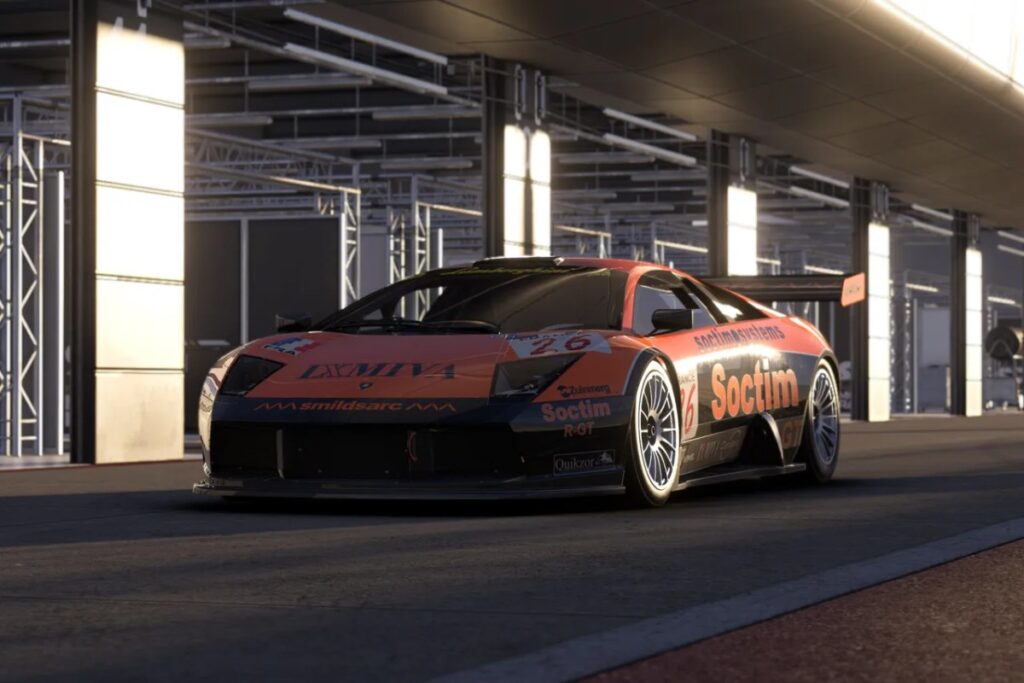
August has been an intense month for the team at Straight4 Studio, culminating in the announcement of the Lamborghini Murciélago R-GT as the latest addition to their Project Motor Racing series. This marks the fifth car unveiled this month, following the likes of the Aston Martin DBR9, Audi R8 LMS GT3 Evo II, Lister Storm GT, and Lamborghini Huracán GT3 Evo2.
The Murciélago R-GT, first introduced in 2004, represents a pivotal moment in Lamborghini’s motorsport history. Designed as a GT-spec race car, it was the brand’s first serious, factory-backed contender in top-level GT racing in over a decade. This development signified a renewed commitment to endurance racing, allowing Lamborghini to compete with some of the world’s most prestigious motorsport brands.
Lamborghini’s Return to Racing: The R-GT Project
By the early 2000s, Lamborghini’s presence in motorsport had been sporadic, with notable attempts in the early 1990s through the Lamborghini LC90 Formula 1 engine program and Diablo-based GT cars. These efforts, however, did not secure a lasting foothold in global racing circuits. It was only after Audi’s acquisition of Lamborghini in 1998 that the idea of a factory-supported race car gained traction.
With Audi’s financial and technical support, Lamborghini collaborated with Reiter Engineering to develop a race-ready version of the Murciélago, the brand’s flagship V12 supercar at the time. The result was the Murciélago R-GT, a car that would soon make its mark in Project Motor Racing.
The Race-Ready Bull
The Murciélago R-GT was a departure from its road-going counterpart, featuring a rear-wheel-drive setup in compliance with GT regulations. This change reduced the car’s weight by approximately 550 kg, bringing it down to around 1,100 kg (2,425 lbs). This reduction not only enhanced the car’s agility but also made it a challenging vehicle to drive, especially in endurance races.
Under the hood, the R-GT boasted a heavily modified 6L V12 engine, derived from the road car, capable of producing around 600 hp, depending on Balance of Performance (BoP) regulations. This power was delivered through a 6-speed sequential gearbox optimized for endurance racing. The car’s aggressive aerodynamic package, including a large rear wing, hinted at its handling tendencies, which leaned towards oversteer.
Competition and Challenges
The Murciélago R-GT primarily competed in the European GT Championship. Despite showing potential, it faced challenges such as mechanical failures and overheating issues. However, it did achieve a notable victory at Valencia in 2004, underscoring Lamborghini’s legitimate racing ambitions. This victory demonstrated that, in capable hands, the Murciélago R-GT could compete with the best in GT racing.
Legacy and Impact
While the victory at Valencia was a standout moment, the Murciélago R-GT’s overall racing career was limited. Today, it is viewed as a bold, albeit flawed, attempt to re-establish Lamborghini in top-level endurance racing. Despite its shortcomings, the Murciélago R-GT played a crucial role in Lamborghini’s motorsport evolution, laying the groundwork for future successes in GT3 racing.
The Murciélago R-GT will forever remain the embodiment of the raw spirit of Sant’Agata Bolognese.
In Project Motor Racing, the Murciélago R-GT is seen as an underdog, yet it offers a unique driving experience. Its unpredictable handling, high-revving engine, and distinctive sound make it an unforgettable car that enthusiasts will want to experience at least once.
The announcement of the Murciélago R-GT in Project Motor Racing is a testament to its enduring legacy. As players take to the virtual tracks, they will not only relive a piece of Lamborghini’s history but also appreciate the engineering and passion that went into creating this iconic racing machine.







